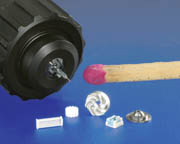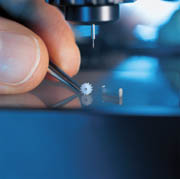
Micromotors, microswitches and precision components usage is growing. Their exact size and surface qualities must guarantee problem-free functionality. Their reliability depends on their quality, which is defined
by measuring.
With its intricate parts, microsystem technology is the challenge facing touch and optical measuring. Because these technologies are being used in measuring small, delicate parts, as well as complex geometries, different measurement principles apply. Consequently, the requirements on a measuring machine for microsystem technology are completely different than those on its larger versions in automobile production or tool making.
Positioning systems with extreme accuracy are required to place and setup the parts to be measured on the measuring machine. At the same time, the holding force must be low enough to ensure that a micropart is not deformed or damaged during the measurement. Consequently, this requires a sensor system on the measuring machine that must work with extremely low measuring forces, guaranteeing that the micropart is not deformed or moved by the machine when it is measured with touch sensors. The F25 coordinate measuring machine (CMM) from Carl Zeiss Industrial Metrology (Maple Grove, MN) produces measuring forces that are approximately 1/400 of the probing force of a large industrial machine.
Computer-aided design (CAD) based software, such as Zeiss' Calypso, is needed for multidimensional measuring tasks on microsystem parts. As the workpiece features are practically invisible to the naked eye, the control data and measuring program are directly programmed in the CAD module and tested for interfering contours and navigation capabilities away from the machine before the measurement. This ensures that all features can be reached with the tiny stylus without a collision.
The feature-controlled and object-oriented Calypso software enables selection of as many features as needed from the entire measurement program-without additional work-and permits their subsequent implementation. This is a decisive advantage when using the measurement program for detailed measurements on the workpiece. The resulting inspection programs can be used on all other CMMs as well. They simply need to be equipped with Calypso software.
The F25 measures with extreme accuracy the tiny parts using touch and optical techniques. So far, its capabilities in quality assurance in microsystem technology have only been tapped. In the interim, this machine will be integrated into the process chain just like its larger versions.
The F25's measuring volume is 3.93 by 3.93 by 3.93 inches. Measurement uncertainty for this volume is less than 250 nanometers at a resolution of 7.5 nanometers. Using minimal probe forces, this resolution and the optimum control of the linear drives, enables touch measurements even in bores less than 1 millimeter in diameter.

Sensors
A touch, passive measuring stylus was developed based on a 6.5 by 6.5 millimeter silicon chip membrane and integrated piezo-resistive elements. The stylus permits measurements in both single point and scanning mode.
The 3-D microstylus is designed for stylus diameters of 50 to 500 micrometers and stylus tip diameters of 100 to 700 micrometers. With a free shaft length of up to 4 millimeters, it is possible to measure in small, deep-lying structures with probe forces of less than 0.5 milli-Newtons per micron (micrometer).
The ViScan camera sensor combined with an objective lens based on those used in Zeiss microscopy, is used as an optical sensor for 2-D measurements. These optics, which are optimized for depth of field and have minimized distortion, ensure accurate measuring results with maximum resolution in reflected and transmitted light.
The combination of touch and optical sensors enables measurements of 2-D and 3-D structures in the same coordinate system. An additional camera aids visualization when probing very small features, thus simplifying part programming.
What makes this measuring technology interesting for the future is that this measuring machine permits dimension, form and position measurements on microsystem modules. This is possible thanks to its special touch sensors whose central component features complex, silicon membrane spring technology. It was developed in a joint effort with the National Metrology Institute and the Institute of Microtechnology, both in Brunswick, Germany.
The F25 will demonstrate its true abilities in the future when this measuring technology is enhanced for integrated quality assurance in microsystem manufacturing processes. It may then be the heart of quality assurance for each microsystem part manufacturer.
This machine and its associated sensors were developed as part of the MiMiKri project sponsored by the German Federal Ministry for Education and Research. Development goals include precise control behavior and extremely low vibration of the coordinate measuring machine in addition to the required accuracy with the short travel paths. A precision kinematic system operating on the Abbe comparator principle was developed during a doctorate project in association with the Institute for Metrology and Technology at the Technical University in Eindhoven, Netherlands.

QUALITY SPECS
The F25 coordinate measuring machine produces measuring forces that are approximately 1/400 of the probing force of a large industrial machine. Its range of applications includes:
4Rotation symmetrical parts with freeform surfaces, small radii
and undercuts.
4Prismatic parts with small and
deep bores.
4Flat metal parts with low form stability.
42-D parts with bores and cut-outs.
Karl Seitz is director of new technology at Carl Zeiss Industrial Metrology GmbH.
Technology Contact
For more information on the
F25 measuring machine, contact:
Annette Smith
Carl Zeiss IMT
6250 Sycamore Lane North
Maple Grove, MN 55369
(763) 744-2400
E-mail: [email protected]
URL: www.zeiss.com/imt